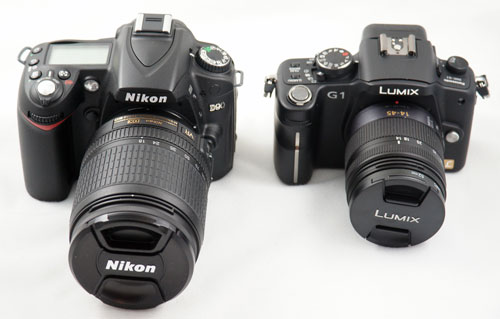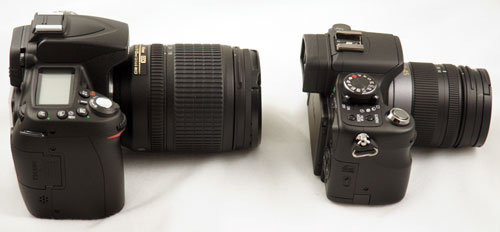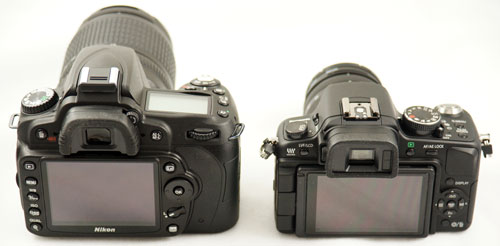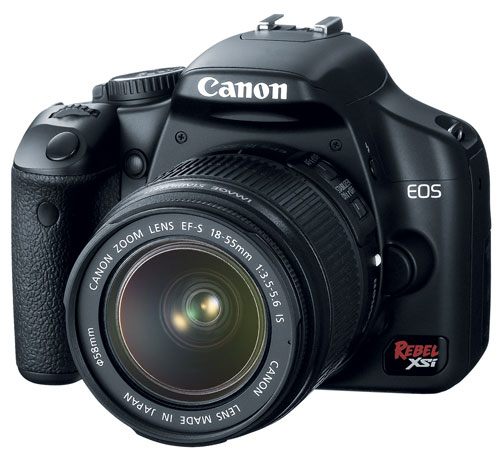Digital Cameras for the Holidays
by Wesley Fink on November 27, 2008 12:00 AM EST- Posted in
- Digital Camera
Entry Interchangeable Lens
Why should you spend more money for a DSLR than a point-and-shoot camera, when resolutions appear similar and the point-and-shoots offer the same features? It's all about the sensor and flexibility. The senor is an analogue device that converts light to a digital signal, so the larger the light gathering points (pixels) the more the ability to gather light and distinguish fine detail. The DSLR sensor is at least ten times larger than the typical P&S, so it can gather more light and resolve finer variations in that light. This means the image quality will be better with a DSLR and the sensor is capable of providing good images over a much wider range of light conditions than a P&S.
This category also features interchangeable lenses so you can choose to mount a wide variety of lenses designed for certain purposes - fast speed for low light, fast telephotos for sports, long telephotos for bird-watching, super wide-angle for sweeping landscapes, etc. The category name had to be changed this year to make way for a brand new category of digital camera. The Panasonic G1 is the first, but likely just the beginning, of the interchangeable lens digital camera without a mirror-box. That means it is not an SLR, but it does compete in the DSLR market space.

A Panasonic G1 recently landed in the lab, and we are mightily impressed. The descriptions of this little mirrorless interchangeable lens digital camera intrigued us, as they did everyone, but in the flesh the G1 is even more revolutionary and impressive.



You can see how small the G1 really is side-by-side with the new Nikon D90. There is the potential for micro 4/3 to go even smaller. The tiny 14-45mm zoom (28-90mm equivalent) really sets the size standard around which the 4/3 system will be built. What the pictures can't show is that while the G1 is small it does not feel cheap or too tiny in the hands. Ergonomics are very good, and the rubberized covering of the body will be loved by most and hated by a few.
The 23-point contrast detect AF is remarkably fast, so you can forget about Live View AF as a limitation - because it is fast on the G1, as fast as an optical DSLR with good phase-detect focusing. The view on the flexible 3" tilt-and-swivel LCD is very bright and clear, and as big as it gets in this class. The detail, with a 420,000 pixel screen, is better than anything else in its category.
The viewfinder is also electronic, but it's not like any of the limited EVF finders we have seen in the past. In most situations you have to remind yourself that this is an EVF, since the view is bigger and brighter than the normal DSLR with a pentamirror. It only gives itself away in very low light where the EVF becomes gritty and tears, but otherwise it is not a handicap at all.
There's lots of good news with the G1, but there is also the price. After using a G1, I understand the pricing at $795 - because it can easily compete in the prosumer class and $795 is a bargain in that space. However, that is not where the G1 will compete. It will be trying to grab market share from entry DSLRs where a $500 price is more appropriate. Fortunately, we already see dealers on eBay selling the G1 kit for $649 to $695. Special promotions like Microsoft Live Search cashback can reduce the price another 25%, getting the eBay final cost down to around $500, where the G1 is an incredible value.
The G1 by itself is good enough to compete in the prosumer market, and that says a lot. However, the micro 4/3 lens system is not here yet. Until there are more choices in micro 4/3 lenses and more 4/3 lenses that work completely on micro 4/3, the system can only be viewed as entry. The potential is certainly there, and as it is the G1 is an easy choice as an entry camera recommendation. You will see more about the G1 in an upcoming review.

In looking at a traditional DSLR in the entry class, the first consideration has to be value. As you saw in Sony A200: Entry DSLR Roundup, the Sony A200 stands out as a great value in a crowded field. The A200 inherits the sensor and electronics refinements of the A350/A300/A700 in a package that updates the A100, a camera originally designed to sell for twice the price of the $499 A200.
The 10.2MP A200 has faster AF than the A100, a larger 2.7" LCD, faster image processing, and more robust adjustment ranges. It also shares an optional battery grip with the A300/A350, correcting an omission on the A100. Neither the Nikon D60 or Olympus E420/E520 offer a battery grip option. The in-body image stabilization, is even more effective on the A200 and it works with any lens you can mount on the camera.
The Sony A200K, which includes the 18-70mm lens, is widely available for $499 or less. However, the 2-lens A200W is the real bargain right now with Sony instant rebates. You can get the two-lens kit, with the addition of the 75-300mm zoom, for around $549 at Amazon and other large etailers. The second lens normally adds $200 to the kit price.

You can never go wrong buying Canon or Nikon as your first serious camera, and it turns out the Canon XSi remains one of the best buys in the Canon line. The XSi price has dropped quite a bit since it was introduced and you can now find this superb 12.2MP camera for $650 or less with the Cannon 18-55mm IS (Image Stabilized) lens. Canon IS is in the lenses and not in the camera body, so you will need to buy IS lenses for that feature.

If every penny counts, as it does for many in these economic times, the 10MP Canon XS provides most of the XSi features in a cheaper package. The XS with the 18-55mm IS lens is selling for around $499, which is the same price as the Sony A200.
Both the XSi and XS feature Live View, which lets the user use the LCD to compose and focus pictures. This is a feature that is missing on the Sony A200. However, Live View focusing is very slow on most of today's DSLR cameras, with the exception of the Sony A300/A350, which feature Live View on a tilt LCD as their primary shooting mode. If Live View interests you, check out these two Sony models as well. The Panasonic G1 is also a Live View camera, but the fast 23-point Live View AF and flexible, accurate tilt-and swivel 3 inch LCD make it a no-compromise Live View solution.










41 Comments
View All Comments
Wesley Fink - Friday, November 28, 2008 - link
We;ve added mention of the Pentax K20D as a great value at $750 to $800 in the Prosumer category. It is not, however, without its probelms, as is true of any camera, and the price has dropped from $1295 to $750 in pretty short order. Its an outstnding value if it fits your needs and the way you shoot.ubiloo - Friday, November 28, 2008 - link
Sorry, I meant 'for at least €100 less'computerfarmer - Thursday, November 27, 2008 - link
If I were to choose.......from this article.Point and shoot:
Panasonic Lumix DMC-L8 for quality, Canon Powershot A590 IS best for the money.
Super Zoom:
Panasonic Lumix LMC-TZ5
Entry Interchangeable Lens:
Canon XSi or XS and Panasonic G1
At this level, all make decent products....hard to choose.
Prosumer:
Nikon D90 or Canon 50D ....hard to choose.
Full-Frame:
Nikon D700 or Canon 5D Mark II
I am about to enter the "Entry Interchangeable Lens" category, perhaps in March or April. I have gone from point and shoot to superzoom. Panisonic FZ8 is camera I have now. It is so much better than the point and shoot. But the cost to go up to the next level is quite substantial. With a kit lens, I will not get the zoom I am accustomed too. The macro part I am unsure of. Then there is the flash. The number one reason for upgrading is the quality of photograph. The question I have is, if I wanted to print 13x19 inch photos, what camera and lens would do the best job for, Portraits, Birds, Indoors....
Example: If I purchased a Canon Rebel XSi; what else would I need to get the most out of this camera(general use). I am thinking the camera with the kit lens, plus a 200mm zoom lens, a macro lens, a flash(wireless would be nice), a good tripod. how much would this cost me?
This article gave a good overall view.....Thank You
strikeback03 - Monday, December 1, 2008 - link
Unless the birds are very tame, 200mm isn't very long. A friend of mine has the XTi with 18-55IS/55-250IS combo though and is very happy with them for general use. The 55-250IS is not that expensive, B&H has a kit with XSi/18-55IS/55-250IS for $708. The 100/2.8 Macro is a good macro lens and also very usable for tighter portraits, runs around $450. No Canon bodies offer wireless flash control in-body, so the flash itself ranges from $200-400 depending on power and features, and if you want wireless you either need remote triggers and external metering, or a ST-E2 wireless transmitter. Tripods are highly dependent on what you want and need, but guessing at least $100 is pretty safe.Note that for some items (lenses, flash) you can sometimes find third-party alternatives which work as well for your needs for less money.
haplo602 - Friday, November 28, 2008 - link
have a look on ebay ...I don't know the canon line of lenses, but something similar to the AF-S DX NIKKOR 18-105mm f/3.5-5.6G ED VR will make a good all-around starter lens.
Maxington - Thursday, November 27, 2008 - link
The G1 is revolutionary alright, its a camera that does away with the mirror box and optical viewfinder, without actually being any smaller than standard DSLRs!Why is this article have such a huge positive bias towards it? It should be applauded for actually trying, but totally dismissed until, like the rest of the 4/3rds range, it actually delivers on making a camera small. How you can recommend it whatsoever is beyond me.
Hell, Pentax have a far smaller setup, with the K2000/Km body, and their pancake lens range. And a better performing sensor with a bigger lens range to boot.
Speaking of Pentax, why were no Pentax cameras recommended? They are far better value for money than Nikon/Canon, though Sony camera bodies are probably the best value, pity their lenses are ridiculously priced.
Wesley Fink - Friday, November 28, 2008 - link
The G1 is a great deal smaller overall than any DSLR we have tested, but it also has many other features going for it, like the superb 3 inch tilt-and swivel hi-res LCD and the first EVF we could actually live with. It also breaks new ground in Live View AF.We agree the Pentax K20D is a great value at $750 to $800, and mention of the K20D has been added. It should also be mentioned that the price of the K20D has declined from $1295 to $750 in pretty short time. The pro-type sealing and 14.6 megapixel sensor are top of the class, but the high ISO noise, inconsistent color at high ISO, slow AF, and slow continuous frame-rates detract from the top-notch features.
gaston1 - Friday, November 28, 2008 - link
Thank you for adding K20D to the list. I agree about the AF being slower than the competition. High ISO noise, not really, I'd say it's in line with other APS-C cameras in its range, although Pentax has taken a different approach, producing grainier pictures at high ISO but preserving much more detail than the others (and can be cleaned very easily through software if one chooses to). ISO 1600 is very useable, 3200 is sort of equivalent to the K10D's 1600, not that clean but useful when needed, and the 6400 is not that useable, in my opinion. We must also not forget that most reviews (comparing jpegs) will have Pentax tested on its default setting with noise reduction off while it kicks in by default on other cameras once you start using higher ISO settings. Canon's ISO 12800 hardly contains any detail at all, and in my opinion is just there for marketing purposes.As far as value goes, Pentax shines when you start considering lenses. I strongly considered going for the Nikon D700 or even waiting for the Canon 5D mkII, both great cameras for low light (or landscape) photography. But after researching the lenses that I would need, the system price was quickly stretching far beyond my amateur's budget (although still a bargain if you're a pro and need the features). I even briefly considered Sony's A900 but had a similar issue with the cost of lenses.
strikeback03 - Monday, December 1, 2008 - link
I don't really see the advantage in Pentax lens prices that you mention. Seems like they have dropped some, as a year ago I initially recommended a K10D with 16-50 2.8 to a friend, expecting the 16-50 to be around $500. I was shocked to see it was around $900 at the time. At least now it is more reasonable. Checking other similar lenses they seem to be mostly in line with Canon/Nikon, with some deals (50/1.4 for $200) and some more expensive (the 77/1.8 vs 85/1.8 from others).Maxington - Friday, November 28, 2008 - link
Echoing what gaston1 said, thanks for adding the K20D to the list.Also echoing the high iso comment, Pentax has higher noise due to it retaining detail and not smearing it away like Nikon/Canon do. I'd rather keep the detail and post-process it later, with much better tools, than let the camera do it.
http://www.dpreview.com/reviews/pentaxk20d/page18....">http://www.dpreview.com/reviews/pentaxk20d/page18....
Look at the mush the others turn into.
I'm still not convinced the minor size drop the Panasonic G1 has makes it worthwhile. (It's about half a cm shorter than the Pentax Km, and about 2cm thinner) It's not small enough to drop into "pocket" range, especially with the lack of pancake lenses, thus any size benefit it has is pretty much pointless. It's still a DSLR to carry. When they get it down to being like a rangefinder, then it'll be worth looking at.
I do like the back lcd and the slick contrast af though.